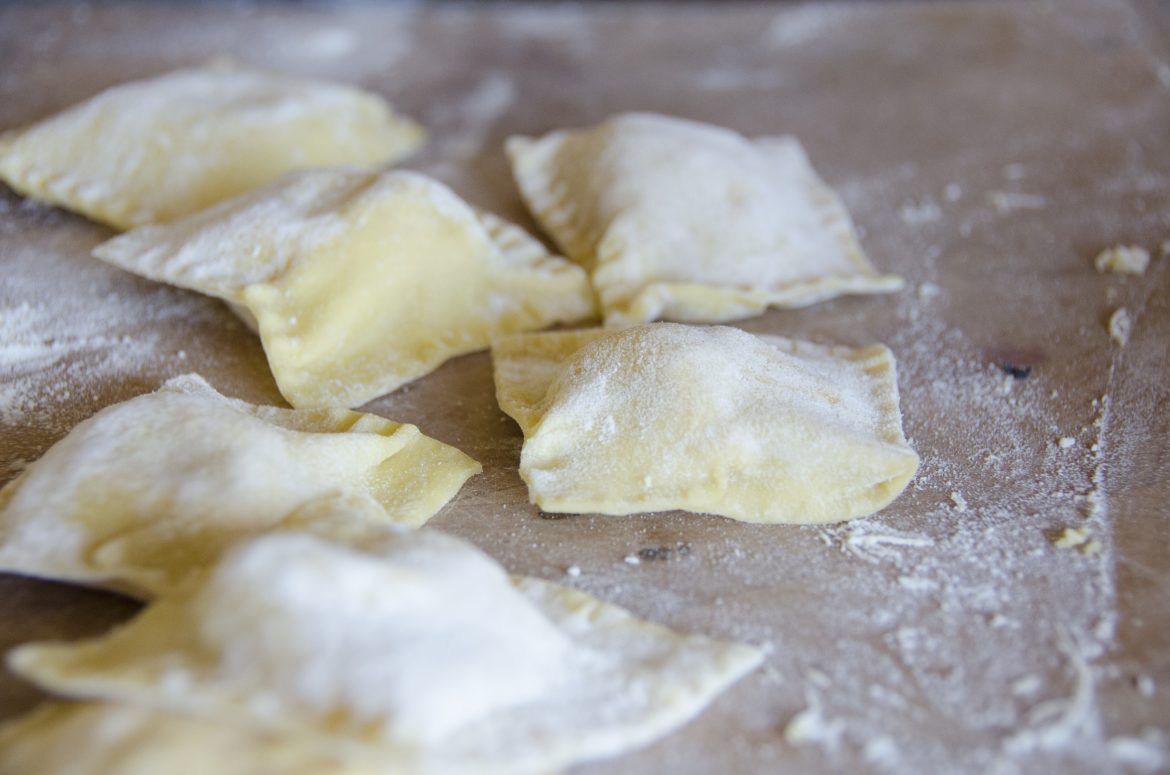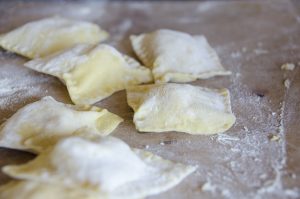Kabocha Ravioli with herbed butter
Delicious Handmade Pasta
Healthy doesn’t come from a can or bag, it comes from handmade products like Kabocha squash wrapped in pillows of pasta dough. Kabocha Ravioli with herbed butter requires little effort and a bit of time to create a delicious dinner. You may never want to eat pasta out again. With the proper tools and some practice, you will never go back to bagged pasta again.
I teach cooking classes in my home and I have been proud of my students when they made their first pasta dough ball. Sure, they weren’t perfect, but it did come together in the end and made delicious ravioli and linguine.
I teach a variety of skills in my classes and I hope to inspire you to venture out of your comfort zone. Explore new foods and techniques that will stay with you through your years of cooking. Your friends and family will thank you.

Filling
1 medium-sized kabocha squash, cooked until tender
1 large eggs, room temperature
1 clove of garlic, smashed and chopped
2 tablespoon olive oil
4 tablespoons grated Parmesan cheese
Salt and pepper
Dough
2 large eggs, room temperature
1 tablespoon olive oil
Pinch of sea salt
1 2/3 cup 50/50 Semolina and ’00’ Flour, plus more for surface
Sauce
4 tablespoon butter
3 tablespoon olive oil
4 tablespoon chopped mixed herbs (parsley, marjoram)
1 clove of garlic, chopped
4 teaspoons grated Parmesan cheese
Pasta Dough
Prepare the pasta dough by putting the flour on the working surface and make a hole in the middle like a volcano. Open the eggs in the center of the crater and beat them slightly with a fork, add a pinch of salt, olive oil and start mixing the liquids. Then start adding flour to the mix gently digging the side of the crater with the fork. Little by little the dough will harden. When the dough starts “staying together” dig your hands and start to knead it, blending and pressing it with the lower part of your palm for many times. If it remains too dry and in flakes add a small quantity of water just wetting your palms. Repeat if needed until you get a dough soft and elastic. You can check if it’s elastic enough putting a finger in the dough: if the dough returns to its previous shape and the hole disappear it’s ready. Let it rest wrap in plastic for a half an hour.
Divide the dough into four small balls. Take one at the time and leave the other under a damp cloth. Roll the dough into a thin sheet with the help of a pasta machine or with a rolling pin. You will have a long sheet of pasta to work with. Place a spoonful of filling on one-half of the sheet separating them approximately 3” apart. Wet the side of the sheet with the filling and then wet in-between each spoonful of filling. Fold the other half of the sheet over the filling you just placed down. Press with the fingers along the borders in order to seal the filling inside the pasta. Try to eliminate the air inside the ravioli start pressing from the center to the sides. Boil the ravioli in a large dutch oven full of salty water for about 8 minutes, constantly giving a look at them! Fresh homemade ravioli usually will float to the top when they are cooked, if they cook too much they will open in the pan. When they have finished cooking drain and add to the prepared sauce.
Filling
Puree the cooked kabocha then add the beaten egg, garlic, olive oil, and parmesan cheese. Season with salt and pepper to taste.
Sauce
In a medium saucepan add the butter and olive oil. When it begins to bubble add the garlic and sauté for a minute, then add the herbs. Mix until they are fragrant. Immediately pour over the ravioli and top with parmesan cheese, serve.

